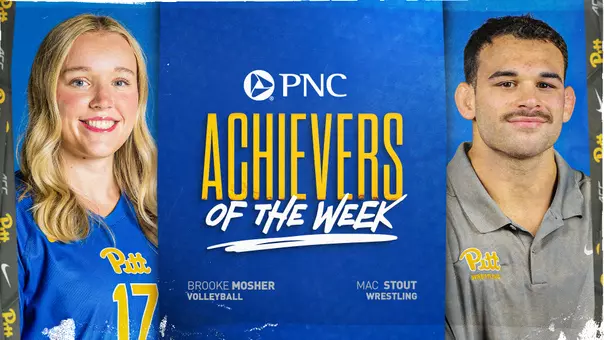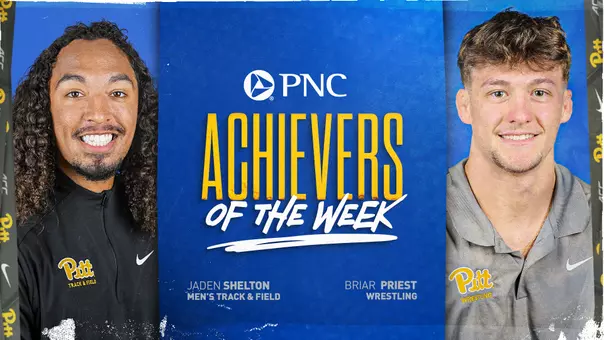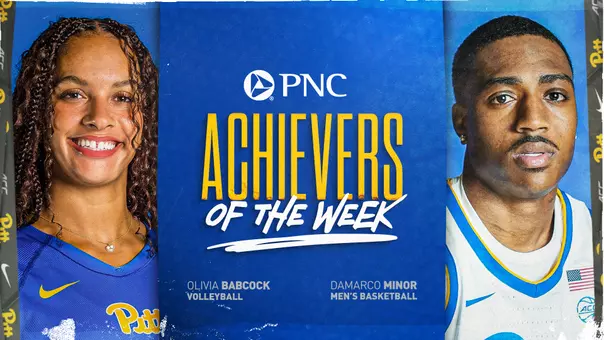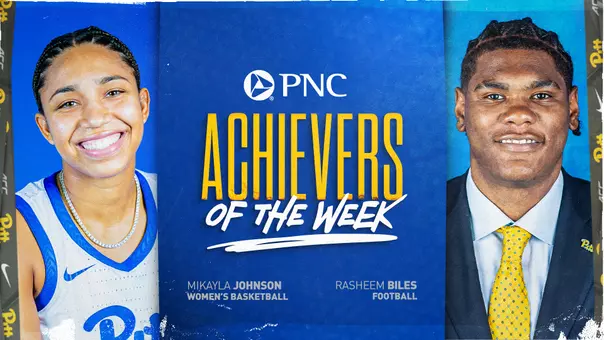University of Pittsburgh Athletics
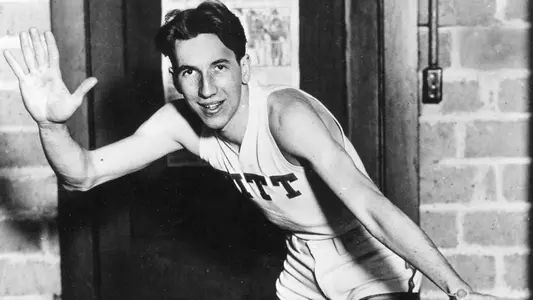
10 on #10: Pitt Athletics Hall of Fame Inductee Charley Hyatt
8/15/2019 10:30:00 AM | General
PITTSBURGH – Numbers were different back in his day. Players did not average 20 points per game, teams did. Uniforms did not have player names on them and many times the images that remain do not show the players number.
Nonetheless, it was the numbers Charley Hyatt, who donned the No. 10 jersey, was able to accumulate during a record-setting career at Pitt (1927-1930) that established him as one of Pitt basketball's greatest players in program history and landed him in the inaugural class (1959) of the Naismith Memorial College Basketball Hall of Fame.
Hyatt led the Panthers to a combined 60-7 record while earning All-America honors each year. He is one of 18 players in NCAA history to earn All-America accolades three times. Pitt earned two Helms Foundation (1928 and 1930) National Championships with Hyatt leading the attack.
Hyatt, who passed away in St. Petersburg, Fla., after a long illness on May 8, 1978 at the age of 71, will be posthumously inducted into the Pitt Athletics Hall of Fame this August. While time keeps on ticking, Hyatt's legacy remains in the stories, anecdotes, accolades and statistics that show his impact on the Pittsburgh basketball community and who he was a person.
A sportswriter once wrote of Hyatt, "this is a true test of an athlete's greatness – even time cannot diminish his exploits."
SUCCESS FROM THE START
Before coming to Pitt, Hyatt was already well known in the area for what he did at Uniontown High School. He played a large role in the group known as the "Five Horsemen." He helped lead Uniontown to a 1925 WPIAL Championship, state championship and the National Scholastic Tournament in Chicago. The horsemen lost to a team from Wichita in the semifinals and ended their season 31-2. Their only other loss that year came to Pitt's freshman team.
The next year, Hyatt once again helped lead the team to a WPIAL Championship, but lost in the playoffs before reaching the state championship game.
"It's been so many years ago, so many years ago, but people in the area, through word of mouth and being handed down from generation to generation, still talk about those Uniontown teams of the 1920s," said local sports historian and Hyatt aficionado George Von Benko. "The Five Horsemen, people still know about the Five Horsemen."
BIG IN HIS DAY
Even though he was a three-time All-American, Helms Foundation Player of the Year and led the nation in scoring in 1930, when he was around basketball in the 1960s, Hyatt could not help but be amazed.
Von Benko remembers Hyatt showing up at Lincolnview Park in Uniontown with his friend and former teammate JS "Bus" Albright, who introduced Hyatt and Von Benko.
"I remember him looking over at the youth on the playground that were playing basketball on the basketball courts outside and he just marveled at the athletic ability of some of these youngsters compared to the years when he played and the better equipment," said Von Benko.
Hyatt joked that at least the children playing basketball now got to play with a round ball, compared to the leather lopsided ball he was accustomed to.
He also noted how big and tall the players were now compared to him. Hyatt stood at 6'0" not very big in today's standards. When he was at Pitt, he was considered to be a big, tall kid and was tabbed "the greatest forward in America". However, 30 years later even Hyatt said he would be considered small if he were playing then.
AGENT OF CHANGE
Hyatt made a name for himself in the basketball community for various reasons, but one of the big ones was his innovation. When Hyatt was playing high school and collegiate basketball, players would shoot the ball with two hands. Hyatt is credited with being one of the first players to lean more toward using one hand and even his left hand.
When watching the next generation of players, Hyatt noticed the difference in the shot. Saying back when he played shooting with one hand would have gotten you pulled, immediately. He was not afraid to test the waters with the one-handed shot and his risk paid huge dividends.
Hyatt twice led the NCAA in scoring (1928 and 1930) and finished his career with 880 points.
With his unmatched scoring prowess, Hyatt was described as "the surest shot that has ever stepped into the stadium at Pitt."
FIRST CLASS & MORE
It was not just people in Pennsylvania who noticed Hyatt was something special. The three-time All-America selection and 1930 Helms Foundation National Player of the Year, continued to garner accolades following his playing career landing a spot in the inaugural Naismith Memorial Hall of Fame Class.
He was inducted along with legendary Pitt head coach Doc Carlson along with other such iconic figures as Phog Allen, George Mikan, Amos Alonzo Stagg and James Naismith, among others.
Hyatt has also been inducted into the Helms Foundation Hall of Fame and was tabbed to its all-time college basketball team, the Pittsburgh City Hall of Fame, Fayetteville County Hall of Fame and now the Pitt Athletics Hall of Fame.
DOC KNOWS BEST
Carlson coached many talented basketball players while at Pitt, but it was Hyatt who stood out to him.
"And naturally I say Hyatt is the greatest basketball player I've ever saw," said Carlson during his time at Pitt. "He had the most deeply engrained desire to play of anybody I've ever met. Basketball was his whole life, nothing else mattered. He would average 30 points a game today; I've never seen anybody who could compare to him."
Carlson had many stories to tell about Hyatt, but his favorite was said to be Pitt's matchup with Notre Dame Feb. 18, 1928. At the end of the first half, Notre Dame was up by nine points. Pitt slowly erased the deficit, but it was not until the last second, when Hyatt made a buzzer beater, that Pitt took its first lead of the game and won 24-22.
"The finish was something to see," Carlson said of the game. "Men cried, women fainted and I felt a warm spot on top of my head, somebody was kissing my bald pate."
HYATT'S HEROICS
As for Hyatt, there were two games he often talked about from his time at Pitt. One was the iconic Pitt versus Notre Dame game during the 1928 championship season. The other was the Pitt versus Montana State game in 1927. Once again, Hyatt was the hero, hitting a last second shot to give Pitt the 38-37 win.
Hyatt scored 27 of Pitt's 38 points that game, while going head-to-head with fellow Hall of Famer John "Cat" Thompson.
Both of Hyatt's buzzer-beaters preserved Helms Foundation Championship seasons for Pitt.
CONTINUED SUCCESS
Hyatt never played professional basketball. He did not see the appeal in playing six to seven basketball games per week and traveling with other men in a car.
"I turned down a chance to make $400 a month to play pro ball with the Cleveland Rosenblums." Hyatt said. "The team included most of the Original Celtics: Joe Lapchick, Carl Husta, Nat Holman, Johnny Beckman, Dutch Dehnert and Davey Banks.
Instead, after Pitt he enjoyed a productive Amateur Athletic Union career with the Diamond Oilers, Universal Pictures, and the Phillips 66ers, earning seven more All-America honors. Hyatt won three AAU national championships, before going on to serve in the Army Air Corps as a second Lieutenant in World War II.
After retiring from basketball and completing his military service, Hyatt was hired as the Midwest sales manager for Spaulding Sporting Goods.
HEARTACHE & HEART-FELT TRIBUTE
Hyatt was preceded in death by his son, also named Charley. His son fought in the Vietnam War and died at sea five years before Hyatt.
The loss of his son was something the elder Hyatt was never able to get over. So much so that when he passed away he was cremated and asked for his ashes to be spread at sea so he could be with his son.
HUMBLE HYATT
As important and basketball was to Hyatt, he was always humble when it came to his talents. He never let the recognition or fame get to him.
According to Von Benko, when he first met Hyatt, he was struck by how humble he was. Going as far as to say the young players he was watching at the playground were better athletes than he had ever been.
CONFIDENT CHARLEY
In the end, Hyatt was a talented basketball player and he knew that. He often told people he would have been able to play in any era of the game and succeed. He knew basketball had changed, he recognized the abilities of others, but was still confident in his success and ability in the game he helped shape.
2019 PITT HALL OF FAME
The 2019 Pitt Athletics Hall of Fame Class was unveiled June 13, 2019 by Pitt's Director of Athletics Heather Lyke. The 12-member group is composed of All-Pros, All-Americans and legendary all-time greats.
The 2019 class will receive induction at the Pitt Hall of Fame Dinner on Friday, Sept. 20, at the Petersen Events Center. On Saturday, Sept. 21, the inductees will be introduced at Heinz Field when the Panthers host UCF. For Hall of Fame Dinner ticket information, contact Executive Director for Signature Events and Donor Experience Allison Rubin by phone (412-648-0345) or email (arubin@athletics.pitt.edu).
For more information of the Pitt Athletics Hall of Fame, visit pittsburghpanthers.com/halloffame.
#H2P | Twitter | Facebook | Instagram
Nonetheless, it was the numbers Charley Hyatt, who donned the No. 10 jersey, was able to accumulate during a record-setting career at Pitt (1927-1930) that established him as one of Pitt basketball's greatest players in program history and landed him in the inaugural class (1959) of the Naismith Memorial College Basketball Hall of Fame.
Hyatt led the Panthers to a combined 60-7 record while earning All-America honors each year. He is one of 18 players in NCAA history to earn All-America accolades three times. Pitt earned two Helms Foundation (1928 and 1930) National Championships with Hyatt leading the attack.
Hyatt, who passed away in St. Petersburg, Fla., after a long illness on May 8, 1978 at the age of 71, will be posthumously inducted into the Pitt Athletics Hall of Fame this August. While time keeps on ticking, Hyatt's legacy remains in the stories, anecdotes, accolades and statistics that show his impact on the Pittsburgh basketball community and who he was a person.
A sportswriter once wrote of Hyatt, "this is a true test of an athlete's greatness – even time cannot diminish his exploits."
SUCCESS FROM THE START
Before coming to Pitt, Hyatt was already well known in the area for what he did at Uniontown High School. He played a large role in the group known as the "Five Horsemen." He helped lead Uniontown to a 1925 WPIAL Championship, state championship and the National Scholastic Tournament in Chicago. The horsemen lost to a team from Wichita in the semifinals and ended their season 31-2. Their only other loss that year came to Pitt's freshman team.
The next year, Hyatt once again helped lead the team to a WPIAL Championship, but lost in the playoffs before reaching the state championship game.
"It's been so many years ago, so many years ago, but people in the area, through word of mouth and being handed down from generation to generation, still talk about those Uniontown teams of the 1920s," said local sports historian and Hyatt aficionado George Von Benko. "The Five Horsemen, people still know about the Five Horsemen."
BIG IN HIS DAY
Even though he was a three-time All-American, Helms Foundation Player of the Year and led the nation in scoring in 1930, when he was around basketball in the 1960s, Hyatt could not help but be amazed.
Von Benko remembers Hyatt showing up at Lincolnview Park in Uniontown with his friend and former teammate JS "Bus" Albright, who introduced Hyatt and Von Benko.
"I remember him looking over at the youth on the playground that were playing basketball on the basketball courts outside and he just marveled at the athletic ability of some of these youngsters compared to the years when he played and the better equipment," said Von Benko.
Hyatt joked that at least the children playing basketball now got to play with a round ball, compared to the leather lopsided ball he was accustomed to.
He also noted how big and tall the players were now compared to him. Hyatt stood at 6'0" not very big in today's standards. When he was at Pitt, he was considered to be a big, tall kid and was tabbed "the greatest forward in America". However, 30 years later even Hyatt said he would be considered small if he were playing then.
AGENT OF CHANGE
Hyatt made a name for himself in the basketball community for various reasons, but one of the big ones was his innovation. When Hyatt was playing high school and collegiate basketball, players would shoot the ball with two hands. Hyatt is credited with being one of the first players to lean more toward using one hand and even his left hand.
When watching the next generation of players, Hyatt noticed the difference in the shot. Saying back when he played shooting with one hand would have gotten you pulled, immediately. He was not afraid to test the waters with the one-handed shot and his risk paid huge dividends.
Hyatt twice led the NCAA in scoring (1928 and 1930) and finished his career with 880 points.
With his unmatched scoring prowess, Hyatt was described as "the surest shot that has ever stepped into the stadium at Pitt."
FIRST CLASS & MORE
It was not just people in Pennsylvania who noticed Hyatt was something special. The three-time All-America selection and 1930 Helms Foundation National Player of the Year, continued to garner accolades following his playing career landing a spot in the inaugural Naismith Memorial Hall of Fame Class.
He was inducted along with legendary Pitt head coach Doc Carlson along with other such iconic figures as Phog Allen, George Mikan, Amos Alonzo Stagg and James Naismith, among others.
Hyatt has also been inducted into the Helms Foundation Hall of Fame and was tabbed to its all-time college basketball team, the Pittsburgh City Hall of Fame, Fayetteville County Hall of Fame and now the Pitt Athletics Hall of Fame.
DOC KNOWS BEST
Carlson coached many talented basketball players while at Pitt, but it was Hyatt who stood out to him.
"And naturally I say Hyatt is the greatest basketball player I've ever saw," said Carlson during his time at Pitt. "He had the most deeply engrained desire to play of anybody I've ever met. Basketball was his whole life, nothing else mattered. He would average 30 points a game today; I've never seen anybody who could compare to him."
Carlson had many stories to tell about Hyatt, but his favorite was said to be Pitt's matchup with Notre Dame Feb. 18, 1928. At the end of the first half, Notre Dame was up by nine points. Pitt slowly erased the deficit, but it was not until the last second, when Hyatt made a buzzer beater, that Pitt took its first lead of the game and won 24-22.
"The finish was something to see," Carlson said of the game. "Men cried, women fainted and I felt a warm spot on top of my head, somebody was kissing my bald pate."
HYATT'S HEROICS
As for Hyatt, there were two games he often talked about from his time at Pitt. One was the iconic Pitt versus Notre Dame game during the 1928 championship season. The other was the Pitt versus Montana State game in 1927. Once again, Hyatt was the hero, hitting a last second shot to give Pitt the 38-37 win.
Hyatt scored 27 of Pitt's 38 points that game, while going head-to-head with fellow Hall of Famer John "Cat" Thompson.
Both of Hyatt's buzzer-beaters preserved Helms Foundation Championship seasons for Pitt.
CONTINUED SUCCESS
Hyatt never played professional basketball. He did not see the appeal in playing six to seven basketball games per week and traveling with other men in a car.
"I turned down a chance to make $400 a month to play pro ball with the Cleveland Rosenblums." Hyatt said. "The team included most of the Original Celtics: Joe Lapchick, Carl Husta, Nat Holman, Johnny Beckman, Dutch Dehnert and Davey Banks.
Instead, after Pitt he enjoyed a productive Amateur Athletic Union career with the Diamond Oilers, Universal Pictures, and the Phillips 66ers, earning seven more All-America honors. Hyatt won three AAU national championships, before going on to serve in the Army Air Corps as a second Lieutenant in World War II.
After retiring from basketball and completing his military service, Hyatt was hired as the Midwest sales manager for Spaulding Sporting Goods.
HEARTACHE & HEART-FELT TRIBUTE
Hyatt was preceded in death by his son, also named Charley. His son fought in the Vietnam War and died at sea five years before Hyatt.
The loss of his son was something the elder Hyatt was never able to get over. So much so that when he passed away he was cremated and asked for his ashes to be spread at sea so he could be with his son.
HUMBLE HYATT
As important and basketball was to Hyatt, he was always humble when it came to his talents. He never let the recognition or fame get to him.
According to Von Benko, when he first met Hyatt, he was struck by how humble he was. Going as far as to say the young players he was watching at the playground were better athletes than he had ever been.
CONFIDENT CHARLEY
In the end, Hyatt was a talented basketball player and he knew that. He often told people he would have been able to play in any era of the game and succeed. He knew basketball had changed, he recognized the abilities of others, but was still confident in his success and ability in the game he helped shape.
2019 PITT HALL OF FAME
The 2019 Pitt Athletics Hall of Fame Class was unveiled June 13, 2019 by Pitt's Director of Athletics Heather Lyke. The 12-member group is composed of All-Pros, All-Americans and legendary all-time greats.
The 2019 class will receive induction at the Pitt Hall of Fame Dinner on Friday, Sept. 20, at the Petersen Events Center. On Saturday, Sept. 21, the inductees will be introduced at Heinz Field when the Panthers host UCF. For Hall of Fame Dinner ticket information, contact Executive Director for Signature Events and Donor Experience Allison Rubin by phone (412-648-0345) or email (arubin@athletics.pitt.edu).
For more information of the Pitt Athletics Hall of Fame, visit pittsburghpanthers.com/halloffame.
#H2P | Twitter | Facebook | Instagram
Pitt Men's Basketball | UPJ Postgame | Omar Witherspoon, Jeff Capel & Nojus Indrusaitis
Tuesday, October 28
Pitt Football | Stanford Week | Coach Narduzzi Presser | 10.27.25
Monday, October 27
Bre Kelley Mic'd Up | Pitt LiveWire presented by UPMC
Wednesday, October 22
9 Minutes of Olivia Babcock’s Record-Breaking 41 Kills vs No. 4 Louisville
Monday, October 20
